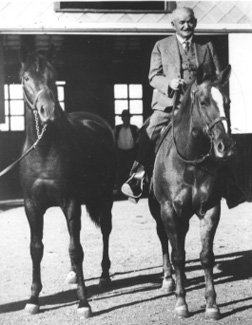
If you haven’t been there or don’t live in North Texas, you might not know that the new $1.15 billion home of the Dallas Cowboys isn’t in Dallas. It’s in Arlington, 20 miles west of Dallas, near the former site of Arlington Downs, acclaimed in the 1930s as one of the world’s finest racetracks.
Arlington Downs left little to be desired in the way of luxury and efficiency. A posh clubhouse served well-heeled Texas Jockey Club patrons, while the main grandstand seated 16,000, with standing room for 10,000 more spectators.
The barns, some of which were still standing 25 years ago, accommodated 1,000 horses, along with their grooms and handlers. Running water, gas and electricity, still luxuries in most rural Texas homes, were available in all the stable areas.
Two tracks – a one-mile track and a one and one-eighth with a one-quarter mile straight shoot – were surrounded by five-inch metal pipes with faucets set in every every 100 feet to serve as a state-of-the-art watering system.
Grandstands, barns, and fences glistened in white and blue and featured the Three D brand of the track’s owner, W.T. Waggoner, (pictured) who unlike Dallas Cowboys’ owner Jerry Jones, footed the entire cost ($5 million in 1929) of his facility.
Once asked if it was his goal to own all of North Texas, Waggoner reported, “No, I don’t aim to buy it all, just what joins me.”
By the late 1920s, Waggoner, whose fortune was based on land and cattle and redoubled by oil discoveries on his ranches, owned over half a million acres in North Texas. Approaching the eighth decade of a life that had denied him little, he had one dream yet to realize – he wanted to build the greatest racetrack in the world and bring legalized wagering to Texas tracks.
When Arlington Downs opened in 1929, wagering had been illegal at Texas tracks since 1909, and it wasn’t until 1933 that Texas Governor Mariam “Ma” Ferguson signed a bill that legalized wagering at Lone Star tracks.
Vice President and native Texan John Nance Gardner, as well Governor Ferguson and humorist Will Rogers were on hand to celebrate the opening of Arlington Downs’ first pari-mutuel meet. Ironically, Waggoner, who had suffered a stroke on the day that Governor Ferguson signed the “racing bill,” was unable to share in the celebration.
During the 1934 meet, Waggoner sometimes sat wrapped in a blanket in a black limousine parked at the stretch and listened as the horses thundered for the wire. But on December 9, 1934, he suffered another stroke and died on December 11 at the age of 82.
In 1936, candidate for governor Jimmy Allred promised to abolish legalized wagering if he was elected. Allred won and he kept his promise. The spring of 1937 was the swan song for Arlington Downs.
After the track was closed, E.P. Waggoner used his father’s adjoining Thoroughbred breeding facility, Three D Stock Farm, as a training division for the Waggoner Ranch in Vernon, Texas. It was here that legendary Quarter Horse sire Poco Bueno was trained, as well as many of his famous offspring.
